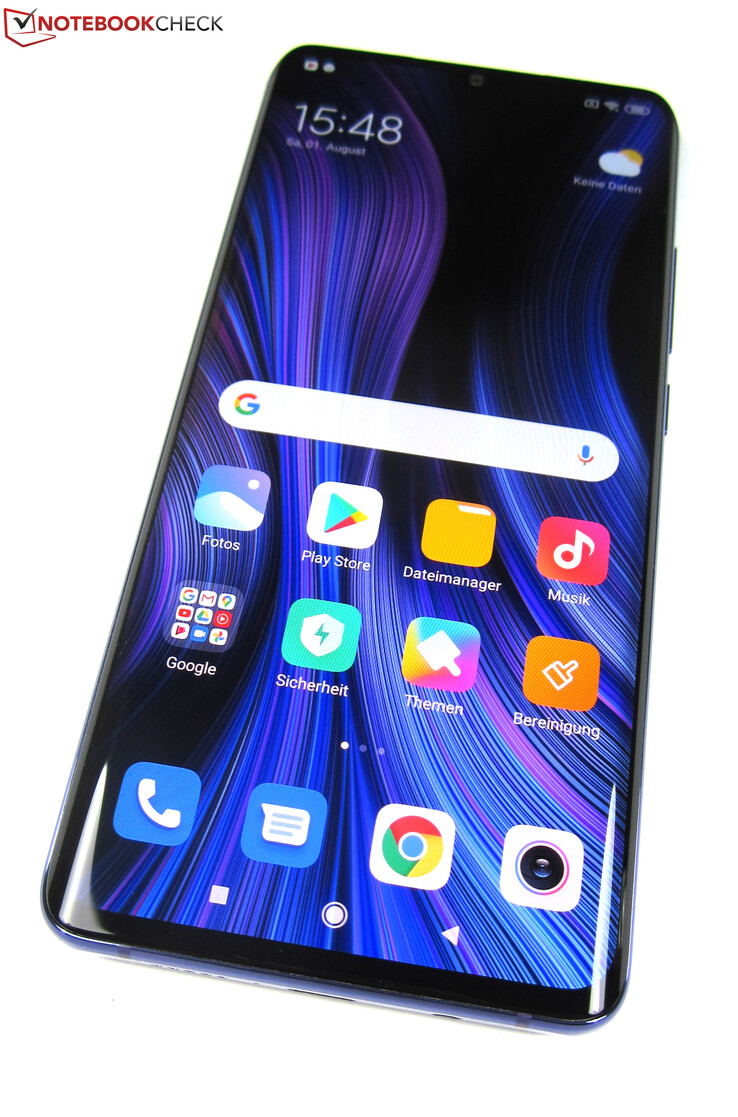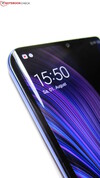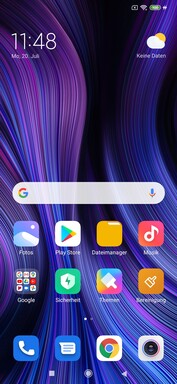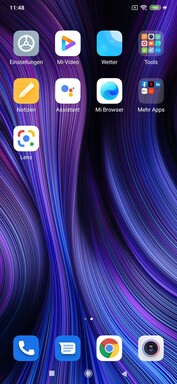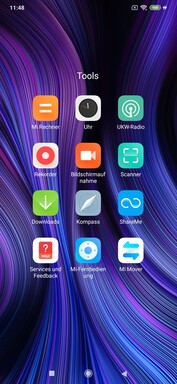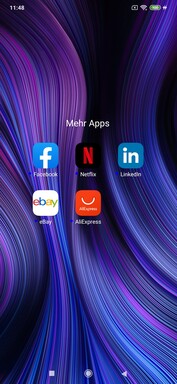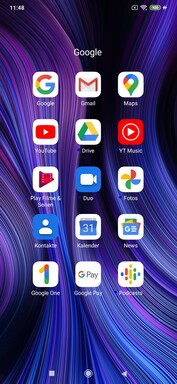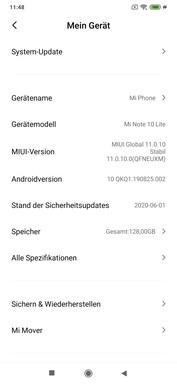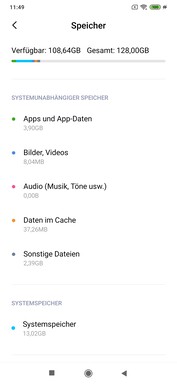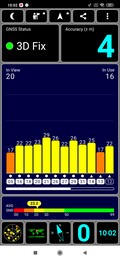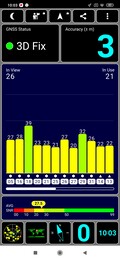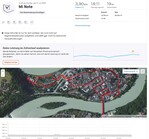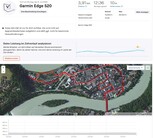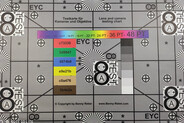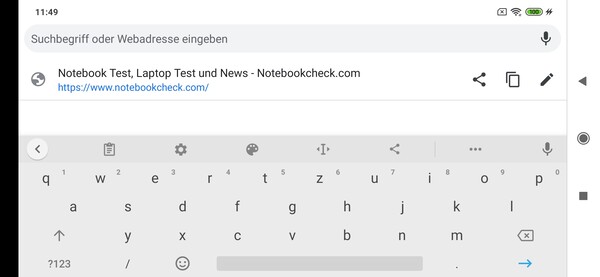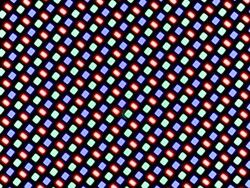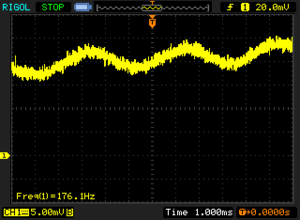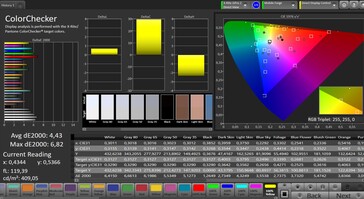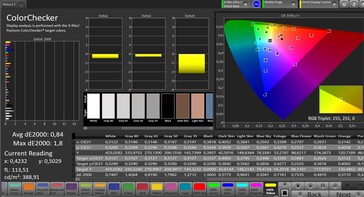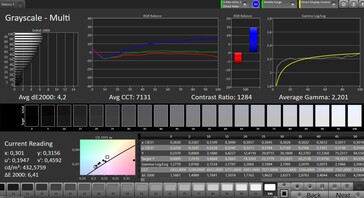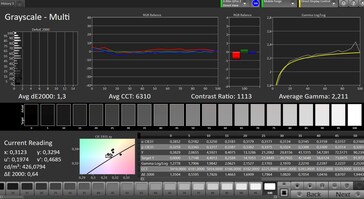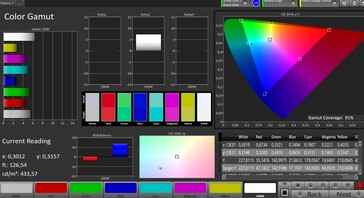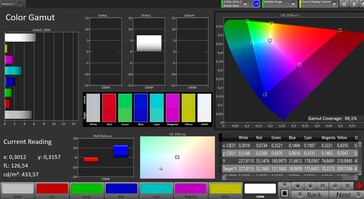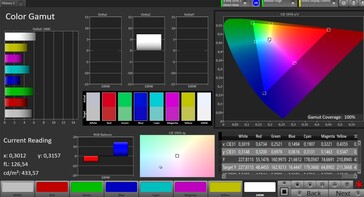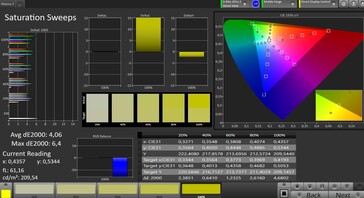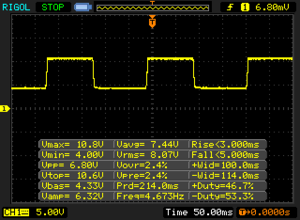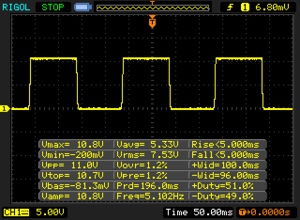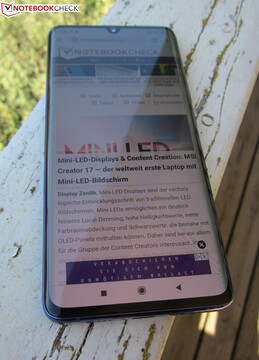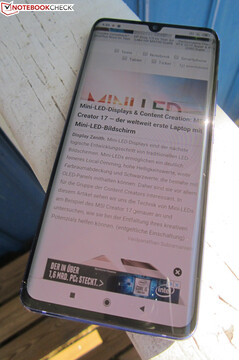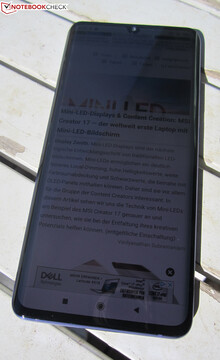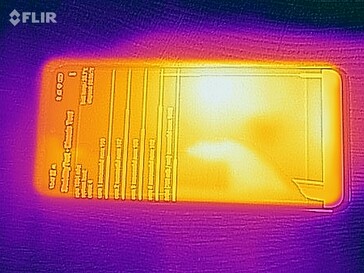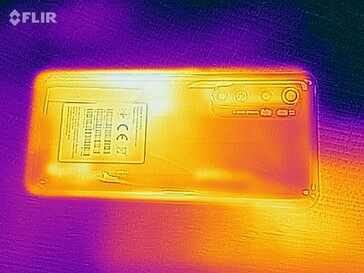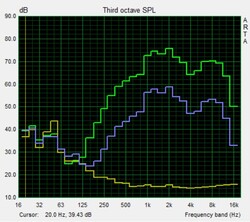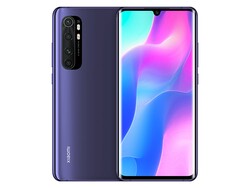Xiaomi Mi Note 10 Lite Smartphone Review – Price-performance Hit
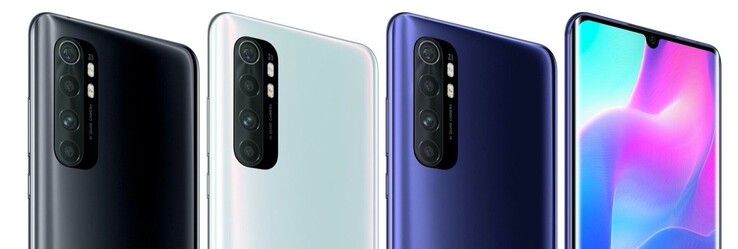
Usually, when the name of a smartphone contains the word "Lite", it indicates that there may be a lot of missing features compared to the non-Lite or standard model. However, this is certainly not the case with the Xiaomi Mi Note 10 Lite.
Surprisingly, the mid-range smartphone barely differs from its high-end sibling Xiaomi Mi Note 10. The former comes with the same 6.47-inch AMOLED display, an equally as large 5260-mAh battery, and the same octa-core Snapdragon 730G SoC.
There really is just one difference: While the Mi Note 10 uses a 108-MP main camera with 5 lenses, the Mi Note 10 Lite only has 64 MP and 4 lenses. This does not look too bad, either.
All things considered, the Xiaomi Mi Note 10 Lite appears to be a clear winner in terms of the price-performance ratio. In this review, we will determine how well the smartphone fares in practice. Of course, we are particularly interested in how well the "Lite" camera performs.
Competing Devices
Rating | Date | Model | Weight | Drive | Size | Resolution | Price |
|---|---|---|---|---|---|---|---|
| 82.9 % v7 (old) | 08 / 2020 | Xiaomi Mi Note 10 Lite SD 730G, Adreno 618 | 204 g | 64 GB UFS 2.0 Flash | 6.47" | 2340x1080 | |
| 82.3 % v7 (old) | 07 / 2020 | Huawei P40 Lite 5G Kirin 820, Mali-G57 MP6 | 189 g | 128 GB UFS 2.1 Flash | 6.50" | 2400x1080 | |
| 81.2 % v7 (old) | 03 / 2020 | Oppo Reno2 SD 730G, Adreno 618 | 189 g | 256 GB UFS 2.0 Flash | 6.50" | 2400x1080 | |
| 79.8 % v7 (old) | 01 / 2020 | Samsung Galaxy A51 Exynos 9611, Mali-G72 MP3 | 172 g | 128 GB UFS 2.0 Flash | 6.50" | 2400x1080 | |
| 83.3 % v7 (old) | 12 / 2019 | Xiaomi Mi Note 10 SD 730G, Adreno 618 | 208 g | 128 GB UFS 2.0 Flash | 6.47" | 2340x1080 |
Case - 3D Glass and a High-End Appearance
The premium case of the Xiaomi Mi Note 10 Lite is worthy of a higher-end device. While the curved glass on the front and back, which combined with the slim metal frame forms a case that not only looks very sleek, but also feels great and makes for a very solid unit overall, is a highlight, there is no IP certification. Due to its glass exterior, the Xiaomi phone is also quite slippery. For better handling, we recommend using the included transparent protective case.
The curved display of the Mi Note 10 Lite is protected by Gorilla Glass 5. Like the front, the glass back cover is also glossy. It diffuses incoming light, which creates beautiful color gradients. Buyers can choose between black, white and purple variants of the Mi Note 10 Lite - our test device is a purple model.
With 157.8 x 74.2 x 9.7 mm (~6.2 x 2.9 x 0.38 in), the dimensions of the Mi Note 10 Lite are identical to those of the Mi Note 10. Although it is slightly lighter at 204 g (~7.2 oz), it is still slightly heavier than other smartphones of its size. That being said, it does not feel heavy in the hand.
Features - NFC, Dual SIM and Up to 128 GB RAM for the Mi Note 10 Lite
Like the Mi Note 10, the Mi Note 10 Lite is also equipped with 6 GB of LPDDR4X RAM. However, there are more storage configurations available: Apart from a 128-GB version, Xiaomi also offers a 64-GB version of its Lite smartphone. Since the price difference is negligible, we recommend skipping the smaller version.
At the time of writing, the 128-GB Mi Note 10 Lite can be purchased for around 370 Euros (~$435) from Xiaomi's online shop, while the 64-GB model costs 340 Euros (~$400). Although the internal storage cannot be expanded due to the lack of a microSD card slot, this option is not available on the Mi Note 10, either.
The otherwise solid features include a USB Type-C port working at 2.0 speeds, which is acceptable for this price class, a 3.5-mm headphone jack, two SIM slots, and an infrared transmitter, which has become a rarity on recent smartphones. NFC is supported as well.
Software - Android 10 and MIUI 11
The Mi Note 10 Lite ships with Android 10 and Xiaomi's own user interface MIUI 11. During our test (beginning of August), the Android security patches from July 1st 2020 were installed, which means they are still quite up-to-date.
Aside from the Google apps and a few of Xiaomi's own tools, the manufacturer has also preinstalled Facebook, Netflix, LinkedIn, eBay, and Aliexpress as well as a few advertisement apps, which can fortunately all be uninstalled. The Mi Note 10 Lite supports DRM Widevine L1, allowing users to stream HD quality video content.
Communication and GPS - Fast and Very Consistent Wi-Fi Transfer Speeds
While the Mi Note 10 Lite does not support the latest wireless standard Wi-Fi 6/Wi-Fi 802.11ax, its Wi-Fi 5/Wi-Fi 802.11ac module still achieves very solid transfer speeds.
In conjunction with our reference router Netgear Nighthawk AX12, the Xiaomi smartphone reaches average download and upload speeds of 324 Mb/s and 341 Mb/s, respectively. Since the Mi Note 10 relies on the same Wi-Fi module, both smartphones achieve identical data transfer rates that are very consistent. However, neither they nor the other devices in our comparison can hold a candle to the Oppo Reno2.
| Networking | |
| iperf3 transmit AX12 | |
| Oppo Reno2 | |
| Xiaomi Mi Note 10 | |
| Xiaomi Mi Note 10 Lite | |
| Samsung Galaxy A51 | |
| Huawei P40 Lite 5G | |
| iperf3 receive AX12 | |
| Oppo Reno2 | |
| Xiaomi Mi Note 10 Lite | |
| Huawei P40 Lite 5G | |
| Xiaomi Mi Note 10 | |
| Samsung Galaxy A51 | |
The Mi Note 10 Lite takes its time to locate us indoors via GPS and reaches an accuracy of within 4 meters (~13 ft). Outdoors, it determines our position significantly faster and the precision increases to be within 3 meters (~10 ft).
On our small bike ride, the Mi Note 10 Lite has to prove its GPS capabilities in a real-world scenario. Relative to the professional navi Garmin Edge 520, which we also brought along for the ride, it does fairly well, the route occasionally takes a shortcut through a building when it comes to tracking our position in the narrow alleys in the old town. However, the deviations from the actual route tend to be small. As a result, the Mi Note 10 Lite can supply apps with relatively precise location data.
Telephony and Call Quality - Xiaomi Mi Note 10 Lite with VoLTE and Wi-Fi Calling
The Mi Note 10 Lite accepts two nano-SIM cards, both of which can be used to connect to 4G cellular networks. Wi-Fi calling and VoLTE is supported. Similar to the Mi Note 10, the call quality is decent overall: Both loud voices and quiet voices are transmitted distinctly and the microphone rarely distorts. In hands-free mode, the voice our conversational partner becomes less acoustically present, although it can still be clearly understood.
Cameras - Up to 64-MP Photos that Look Great In Daylight
While the Xiaomi Mi Note 10 has a 108-MP camera with five lenses, the Mi Note 10 Lite does not have as much to work with. Being equipped with a quad-camera that is not quite as impressive on paper, still has a lot to offer.
The Mi Note 10 Lite uses a 64-MP camera based on the Sony IMX686 sensor (f/1.89, 1/1.73", 0.8 µm). Due to pixel-binning, it captures pictures with a resolution of 16 MP. Users who wish to make use of the full resolution will not have to overcome any artificial restrictions. Instead, the camera simply offers a "64M" mode.
Unlike the Mi Note 10, the Mi Note 10 Lite comes without an optical image stabilizer and the ultra-wide-angle camera has a resolution of only 8 MP instead of 20 MP. Additionally, lenses three and four are depth sensors with a resolution of 5 MP and a 2-MP macro camera, respectively. Meanwhile, the selfie camera has 16 MP (Mi Note 10: 32 MP).
The Mi Note 10 Lite's image quality is convincing despite the lower-end camera setup. Under good lighting conditions, the smartphone captures sharp and detailed pictures that manage to look very vivid thanks to their high dynamic range without oversaturating the scene. An even higher sharpness and a higher level of detail are possible with the 64-MP mode.
Compared to more expensive smartphones, the shortcomings of the Xiaomi Mi Note 10 Lite's main camera in terms of the quality only become apparent when taking pictures in poorly-lit environments. Here, the sharpness of the pictures decreases slightly and image noise becomes somewhat noticeable, although the camera is still suitable for snapshots.
The Mi Note 10 Lite can record videos at up to 4K with 30 frames per second and the quality of the recordings also looks good. However, unlike with the Mi Note 10, a steady hand is required due to the lack of an optical image stabilizer. At 30 FPS, this is still fairly manageable, whereas at higher frame rates such as at Full HD with 60 FPS, the recordings tend to look rather shaky.
Image comparison
Choose a scene and navigate within the first image. One click changes the position on touchscreens. One click on the zoomed-in image opens the original in a new window. The first image shows the scaled photograph of the test device.
Tageslicht-Szene 1Tageslicht-Szene 2WeitwinkelLowlightTesting the Mi Note 10 Lite under controlled lighting conditions yields results that are very similar to those out in the wild.
Under poor lighting conditions, simulated by the top test chart being captured at a light intensity of 1 lux, the smartphone noticeably struggles to capture the colors. The test chart captured under ideal lighting (bottom test chart) paints an entirely different picture. Here, the color deviations are generally very small with white tones being represented most accurately.
Similarly, the test chart captured under ideal illumination looks sharp as well. While the images lose sharpness towards the edges, the effect is not too pronounced.
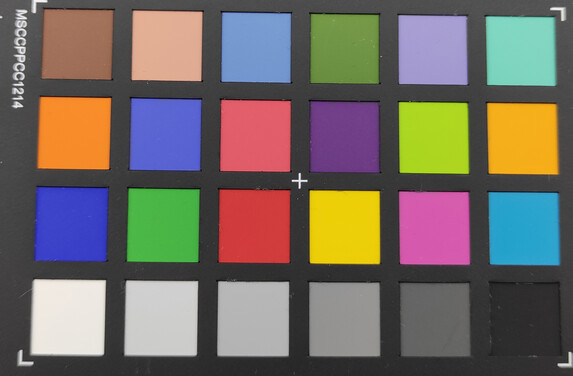
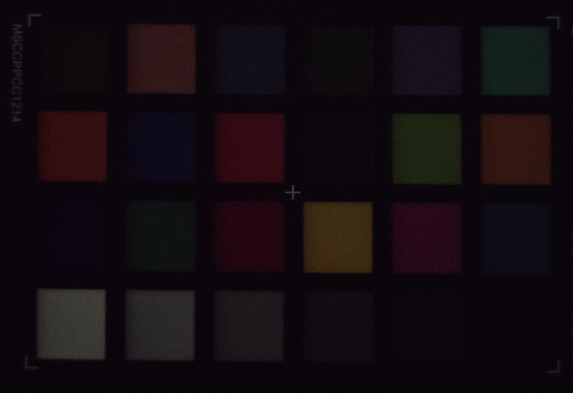
Accessories and Warranty - 30-watt Quick Charger and a Protective Case
The Xiaomi Mi Note 10 Lite's scope of delivery includes a modular 30-watt charger, a USB cable (Type-C to Type-A), headphones, a SIM tool, a transparent protective case, a user guide, and a warranty card. The manufacturer currently offers no specific accessories for the smartphone.
The Xiaomi Mi Note 10 Lite comes with a 24-month warranty.
Input Devices & Handling - Precise Touchscreen, In-Display Fingerprint Sensor
Powered by the octa-core Snapdragon 730G SoC, the Xiaomi Mi Note 10 Lite achieves a fast system performance and shines with great responsiveness. It registers inputs very quickly, regardless of whether they are made via the accurate touchscreen or the physical buttons.
The fingerprint sensor that has been integrated into the display quickly and reliably unlocks the smartphone. The same holds true for the slightly less secure facial recognition.
Display - Xiaomi Mi Note 10 Lite with a Bright AMOLED Screen
A big selling point of the Mi Note 10 Lite is its 2340x1080-pixel AMOLED panel, which offers great colors thanks to its theoretically infinite contrast ratio. Combined with a display size of 6.47 inches, the Xiaomi phone reaches a pixel density of 399 PPI, which guarantees a clear picture.
With an average brightness of 608.3 cd/m², the Mi Note 10 Lite has a very high luminance. In a test with an even distribution of bright and dark areas (APL50), the maximum luminance increases to an even higher value of 683 cd/m². Without the ambient light sensor, the maximum brightness drops to 434 cd/m².
However, the AMOLED display has one disadvantage: It uses PWM to control the brightness, which sensitive users may perceive as bothersome flickering.
| |||||||||||||||||||||||||
Brightness Distribution: 95 %
Center on Battery: 605 cd/m²
Contrast: ∞:1 (Black: 0 cd/m²)
ΔE ColorChecker Calman: 0.84 | ∀{0.5-29.43 Ø4.77}
ΔE Greyscale Calman: 1.3 | ∀{0.09-98 Ø5}
100% sRGB (Calman 2D)
Gamma: 2.211
CCT: 6310 K
| Xiaomi Mi Note 10 Lite AMOLED, 2340x1080, 6.5" | Huawei P40 Lite 5G IPS, 2400x1080, 6.5" | Oppo Reno2 AMOLED, 2400x1080, 6.5" | Samsung Galaxy A51 AMOLED, 2400x1080, 6.5" | Xiaomi Mi Note 10 AMOLED, 2340x1080, 6.5" | |
|---|---|---|---|---|---|
| Screen | -80% | -132% | -105% | -153% | |
| Brightness middle (cd/m²) | 605 | 466 -23% | 679 12% | 589 -3% | 625 3% |
| Brightness (cd/m²) | 608 | 457 -25% | 683 12% | 589 -3% | 607 0% |
| Brightness Distribution (%) | 95 | 91 -4% | 98 3% | 94 -1% | 89 -6% |
| Black Level * (cd/m²) | 0.61 | ||||
| Colorchecker dE 2000 * | 0.84 | 2.2 -162% | 3.5 -317% | 2.22 -164% | 4.38 -421% |
| Colorchecker dE 2000 max. * | 1.8 | 4.6 -156% | 6.8 -278% | 8.24 -358% | 6.83 -279% |
| Greyscale dE 2000 * | 1.3 | 2.7 -108% | 4.2 -223% | 2.6 -100% | 4.1 -215% |
| Gamma | 2.211 100% | 2.24 98% | 2.27 97% | 2.111 104% | 2.251 98% |
| CCT | 6310 103% | 6633 98% | 6532 100% | 6508 100% | 7251 90% |
| Contrast (:1) | 764 |
* ... smaller is better
Screen Flickering / PWM (Pulse-Width Modulation)
| Screen flickering / PWM detected | 176.1 Hz | ||
The display backlight flickers at 176.1 Hz (worst case, e.g., utilizing PWM) . The frequency of 176.1 Hz is relatively low, so sensitive users will likely notice flickering and experience eyestrain at the stated brightness setting and below. In comparison: 53 % of all tested devices do not use PWM to dim the display. If PWM was detected, an average of 8081 (minimum: 5 - maximum: 343500) Hz was measured. | |||
The high luminance of the AMOLED panel is accompanied by other good display characteristics. For optimal colors, users should switch the color mode from "automatic" to "standard". As our CalMAN measurements show, the color deviations are then very close to ideal at a DeltaE of 1.3 and almost overkill for a smartphone. At a DeltaE of 3 or below, the difference between a color and its reference color becomes almost too subtle to notice.
Display Response Times
| ↔ Response Time Black to White | ||
|---|---|---|
| 8 ms ... rise ↗ and fall ↘ combined | ↗ 3 ms rise | |
| ↘ 5 ms fall | ||
| The screen shows fast response rates in our tests and should be suited for gaming. In comparison, all tested devices range from 0.1 (minimum) to 240 (maximum) ms. » 21 % of all devices are better. This means that the measured response time is better than the average of all tested devices (20.2 ms). | ||
| ↔ Response Time 50% Grey to 80% Grey | ||
| 10 ms ... rise ↗ and fall ↘ combined | ↗ 5 ms rise | |
| ↘ 5 ms fall | ||
| The screen shows good response rates in our tests, but may be too slow for competitive gamers. In comparison, all tested devices range from 0.165 (minimum) to 636 (maximum) ms. » 22 % of all devices are better. This means that the measured response time is better than the average of all tested devices (31.6 ms). | ||
Due to its high brightness, the Mi Note 10 Lite does very well when it comes to outdoor use as long as the phone is not used under direct sunlight. Similarly, the viewing angles warrant no criticism. The screen content remains discernible even when viewed from a very steep angle.
Performance - Fast Mid-range SoC
The Mi Note 10 Lite features the Snapdragon 730G, an octa-core SoC from the upper mid-range segment with more than enough performance for day-to-day app use. However, its limitations become apparent when running more demanding applications or while multitasking.
Since unlike the normal Snapdragon 730, the Snapdragon 730G's "G" suffix indicates that has been specifically optimized for games, it is a good choice for gamers. More specifically, Qualcomm has adapted a few of the Wi-Fi features and increased the clock speed of the GPU Adreno 618. Graphics-intensive benchmarks such as GFXBench and 3DMark still show the Huawei P40 Lite 5G to be an even more interesting device for gamers.
| PCMark for Android | |
| Work performance score (sort by value) | |
| Xiaomi Mi Note 10 Lite | |
| Huawei P40 Lite 5G | |
| Oppo Reno2 | |
| Samsung Galaxy A51 | |
| Xiaomi Mi Note 10 | |
| Average Qualcomm Snapdragon 730G (8941 - 10200, n=7) | |
| Work 2.0 performance score (sort by value) | |
| Xiaomi Mi Note 10 Lite | |
| Huawei P40 Lite 5G | |
| Oppo Reno2 | |
| Samsung Galaxy A51 | |
| Xiaomi Mi Note 10 | |
| Average Qualcomm Snapdragon 730G (7134 - 8683, n=7) | |
| AnTuTu v8 - Total Score (sort by value) | |
| Xiaomi Mi Note 10 Lite | |
| Huawei P40 Lite 5G | |
| Oppo Reno2 | |
| Samsung Galaxy A51 | |
| Xiaomi Mi Note 10 | |
| Average Qualcomm Snapdragon 730G (251673 - 275660, n=6) | |
The Mi Note 10 Lite quickly loads web pages, which makes for smooth web browsing. Since both the Oppo Reno2 and particularly the Huawei P40 Lite 5G perform even better in this discipline, our test device does not manage to secure one of the top spots in our browser benchmarks.
| Jetstream 2 - 2.0 Total Score | |
| Average of class Smartphone (23.8 - 387, n=147, last 2 years) | |
| Huawei P40 Lite 5G (Huawei Browser 10.0.2.331) | |
| Average Qualcomm Snapdragon 730G (45.8 - 50.6, n=6) | |
| Xiaomi Mi Note 10 Lite (Chrome 83.0.4103.106) | |
| Xiaomi Mi Note 10 (Chrome 78) | |
| Oppo Reno2 (Chrome 80) | |
| Samsung Galaxy A51 (Chrome 79) | |
| JetStream 1.1 - Total Score | |
| Huawei P40 Lite 5G (Huawei Browser 10.0.2.331) | |
| Oppo Reno2 (Chrome 80) | |
| Average Qualcomm Snapdragon 730G (79.2 - 87.7, n=6) | |
| Xiaomi Mi Note 10 Lite (Chrome 83.0.4103.106) | |
| Xiaomi Mi Note 10 (Chrome 78) | |
| Samsung Galaxy A51 (Chrome 79) | |
| Speedometer 2.0 - Result 2.0 | |
| Average of class Smartphone (15.2 - 643, n=119, last 2 years) | |
| Huawei P40 Lite 5G (Huawei Browser 10.0.2.331) | |
| Oppo Reno2 (Chrome 80) | |
| Xiaomi Mi Note 10 (Chrome 78) | |
| Average Qualcomm Snapdragon 730G (40.4 - 44.2, n=6) | |
| Xiaomi Mi Note 10 Lite (Chrome 83.0.4103.106) | |
| Samsung Galaxy A51 (Chrome 79) | |
| WebXPRT 3 - Overall | |
| Average of class Smartphone (38 - 380, n=30, last 2 years) | |
| Huawei P40 Lite 5G (Huawei Browser 10.0.2.331) | |
| Xiaomi Mi Note 10 (Chrome 78) | |
| Xiaomi Mi Note 10 Lite (Chrome 83.0.4103.106) | |
| Average Qualcomm Snapdragon 730G (66 - 77, n=6) | |
| Oppo Reno2 (Chrome 80) | |
| Samsung Galaxy A51 (Chrome 79) | |
| Octane V2 - Total Score | |
| Average of class Smartphone (2228 - 126661, n=194, last 2 years) | |
| Huawei P40 Lite 5G (Huawei Browser 10.0.2.331) | |
| Oppo Reno2 (Chrome 80) | |
| Average Qualcomm Snapdragon 730G (16197 - 17768, n=6) | |
| Xiaomi Mi Note 10 (Chrome 78) | |
| Xiaomi Mi Note 10 Lite (Chrome 83.0.4103.106) | |
| Samsung Galaxy A51 (Chrome 79) | |
| Mozilla Kraken 1.1 - Total | |
| Samsung Galaxy A51 (Chrome 79) | |
| Oppo Reno2 (Chrome 80) | |
| Xiaomi Mi Note 10 Lite (Chrome 83.0.4103.106) | |
| Average Qualcomm Snapdragon 730G (2770 - 3054, n=6) | |
| Xiaomi Mi Note 10 (Chrome 78) | |
| Huawei P40 Lite 5G (Huawei Browser 10.0.2.331) | |
| Average of class Smartphone (257 - 28190, n=154, last 2 years) | |
* ... smaller is better
Xiaomi equips the Mi Note 10 Lite with 64-GB or 128-GB of UFS storage, depending on the model. While the specifications suggest the use of UFS 2.1 storage, the measured speeds, which are incidentally almost identical to those of the higher-end Mi Note 10, indicate that in fact, only UFS 2.0 storage has been installed. Overall, the Mi Note 10 Lite is the runner-up in our memory benchmarks, where the Huawei P40 Lite 5G is once again able to claim first place.
| Xiaomi Mi Note 10 Lite | Huawei P40 Lite 5G | Oppo Reno2 | Samsung Galaxy A51 | Xiaomi Mi Note 10 | Average 64 GB UFS 2.0 Flash | Average of class Smartphone | |
|---|---|---|---|---|---|---|---|
| AndroBench 3-5 | 44% | -22% | -12% | -4% | -16% | 355% | |
| Sequential Read 256KB (MB/s) | 501 | 905 81% | 469.3 -6% | 496.1 -1% | 480.5 -4% | 513 ? 2% | 2235 ? 346% |
| Sequential Write 256KB (MB/s) | 213.2 | 188 -12% | 201.8 -5% | 184.9 -13% | 243.6 14% | 175.2 ? -18% | 1871 ? 778% |
| Random Read 4KB (MB/s) | 134.6 | 146.1 9% | 144.2 7% | 110.8 -18% | 106.2 -21% | 117.1 ? -13% | 297 ? 121% |
| Random Write 4KB (MB/s) | 125.8 | 249.7 98% | 22 -83% | 104.4 -17% | 118.9 -5% | 81.1 ? -36% | 343 ? 173% |
| Sequential Read 256KB SDCard (MB/s) | 83.3 ? | 74.5 ? | 73 ? | 73.4 ? | |||
| Sequential Write 256KB SDCard (MB/s) | 67.7 ? | 53.5 ? | 60.1 ? | 55.4 ? |
Gaming - 60-Hz Panel and an SoC Optimized for Games
Thanks to its Snapdragon 730G, which has been optimized for gaming performance, the Mi Note 10 Lite is able to run the latest games smoothly. As our tests with the tool Gamebench show, the smartphone holds its own even in demanding titles such as "Asphalt 9: Legends" and "PUBG Mobile".
The AMOLED display has a refresh rate of up to 60 Hz, although not every game is able to deliver frames at this rate. While for example the games we tested ran smoothly, they were limited to a maximum of 30 frames per second.
Emissions - Xiaomi with No Throttling Under Load
Temperature
While idling, the Mi Note 10 Lite remains inconspicuously cool at just above 30 °C (~86 °F) and even under load, it does not heat up significantly. On average, we measured a temperature of 37.4 °C (~99 °F) on the front and back, which is very far from critical levels.
Internally, there are no issues, either, and as GFXBench's battery test shows, the SoC is able to access its full performance potential at any time. Both in the graphically less intensive T-Rex scenario and the more demanding Manhattan scenario, the initial frame rates do not drop even after rendering the same scene 30 times in succession, which illustrates that there is no throttling.
(±) The maximum temperature on the upper side is 40.1 °C / 104 F, compared to the average of 35.2 °C / 95 F, ranging from 21.9 to 247 °C for the class Smartphone.
(+) The bottom heats up to a maximum of 36.9 °C / 98 F, compared to the average of 34 °C / 93 F
(±) In idle usage, the average temperature for the upper side is 32.4 °C / 90 F, compared to the device average of 32.9 °C / 91 F.
Speaker
The Mi Note 10 Lite houses a single speaker that is able to play without distortions at volume levels of up to a relatively high maximum of 83 dB(A). While its capabilities are sufficient for occasional music and video playback as well as hands-free mode, the sound is relatively thin due to a lack of bass.
Meanwhile, external speakers or a headset connected to the headphone jack or paired Bluetooth devices are able to offer a significantly improved audio experience. Aside from aptx and aptX HD, the Mi Note 10 Lite also supports aptX Adaptive.
Xiaomi Mi Note 10 Lite audio analysis
(+) | speakers can play relatively loud (83 dB)
Bass 100 - 315 Hz
(-) | nearly no bass - on average 67.8% lower than median
(+) | bass is linear (0% delta to prev. frequency)
Mids 400 - 2000 Hz
(-) | nearly no mids - on average 67.8% lower than median
(+) | mids are linear (0% delta to prev. frequency)
Highs 2 - 16 kHz
(-) | nearly no highs - on average 67.8% lower than median
(+) | highs are linear (0% delta to prev. frequency)
Overall 100 - 16.000 Hz
(-) | overall sound is not linear (118.7% difference to median)
Compared to same class
» 88% of all tested devices in this class were better, 8% similar, 4% worse
» The best had a delta of 11%, average was 35%, worst was 134%
Compared to all devices tested
» 96% of all tested devices were better, 3% similar, 1% worse
» The best had a delta of 4%, average was 24%, worst was 134%
Xiaomi Mi Note 10 audio analysis
(+) | speakers can play relatively loud (83.6 dB)
Bass 100 - 315 Hz
(-) | nearly no bass - on average 69.6% lower than median
(+) | bass is linear (0% delta to prev. frequency)
Mids 400 - 2000 Hz
(-) | nearly no mids - on average 69.6% lower than median
(+) | mids are linear (0% delta to prev. frequency)
Highs 2 - 16 kHz
(-) | nearly no highs - on average 69.6% lower than median
(+) | highs are linear (0% delta to prev. frequency)
Overall 100 - 16.000 Hz
(-) | overall sound is not linear (119.9% difference to median)
Compared to same class
» 89% of all tested devices in this class were better, 8% similar, 3% worse
» The best had a delta of 11%, average was 35%, worst was 134%
Compared to all devices tested
» 97% of all tested devices were better, 3% similar, 1% worse
» The best had a delta of 4%, average was 24%, worst was 134%
Battery Life - XXL Battery Does Not Quit
Energy Consumption
With 1.1 watts while idling and 3.7 watts under load, the Mi Note 10 Lite is the most energy-efficient device in our comparison. Only the Oppo Reno2 even comes close to its level of efficiency.
| Off / Standby | |
| Idle | |
| Load |
|
Key:
min: | |
| Xiaomi Mi Note 10 Lite 5260 mAh | Huawei P40 Lite 5G 4000 mAh | Oppo Reno2 4000 mAh | Samsung Galaxy A51 4000 mAh | Xiaomi Mi Note 10 5260 mAh | Average Qualcomm Snapdragon 730G | Average of class Smartphone | |
|---|---|---|---|---|---|---|---|
| Power Consumption | -24% | -7% | -23% | -28% | -28% | -40% | |
| Idle Minimum * (Watt) | 0.8 | 0.65 19% | 0.7 12% | 0.9 -13% | 0.7 12% | 0.84 ? -5% | 0.847 ? -6% |
| Idle Average * (Watt) | 1.1 | 2.25 -105% | 1.25 -14% | 1.7 -55% | 1.8 -64% | 1.953 ? -78% | 1.446 ? -31% |
| Idle Maximum * (Watt) | 1.8 | 2.29 -27% | 1.36 24% | 1.8 -0% | 2.2 -22% | 2.26 ? -26% | 1.63 ? 9% |
| Load Average * (Watt) | 3.7 | 3.7 -0% | 5.38 -45% | 5.2 -41% | 5.2 -41% | 4.51 ? -22% | 6.95 ? -88% |
| Load Maximum * (Watt) | 6.1 | 6.46 -6% | 6.71 -10% | 6.6 -8% | 7.5 -23% | 6.63 ? -9% | 11.3 ? -85% |
* ... smaller is better
Battery Life
Thanks to its 5260-mAh battery, the Mi Note 10 Lite achieves outstanding runtimes. It lasts almost 19 hours while under a simulated web-browsing load and just under 24 hours while playing an H.264 video.
Even with intensive use, the smartphone will likely last for at least one or even two days without having to be recharged. In this discipline, only the Mi Note 10 can compete with ever-so-slightly better runtimes despite a higher energy consumption. That being said, its advantage is very small.
The Mi Note 10 Lite can be recharged via its massive 30-watt charger, which recharges the battery very quickly. In our test, we were able to fully recharge the empty battery within 80 minutes.
| Xiaomi Mi Note 10 Lite 5260 mAh | Huawei P40 Lite 5G 4000 mAh | Oppo Reno2 4000 mAh | Samsung Galaxy A51 4000 mAh | Xiaomi Mi Note 10 5260 mAh | |
|---|---|---|---|---|---|
| Battery runtime | -4% | -24% | -29% | 5% | |
| Reader / Idle (h) | 37.5 | 42.2 13% | 28.2 -25% | 35.6 -5% | |
| H.264 (h) | 22.8 | 18.8 -18% | 14.1 -38% | 23.7 4% | |
| WiFi v1.3 (h) | 18.3 | 17.5 -4% | 10.3 -44% | 11.6 -37% | 18.8 3% |
| Load (h) | 5.6 | 3.1 -45% | 4.8 -14% | 6.5 16% |
Pros
Cons
Verdict - Above-average Features for a Small Price
"Great camera, small compromises", this summarizes our verdict on the Xiaomi Mi Note 10. When taking this as a reference point, the verdict on the Mi Note 10 Lite has to be: Still a good camera and no further compromises compared to the Mi Note 10.
The Lite version offers everything that made the high-end alternative great: A great build quality, a bright AMOLED screen, extremely long battery life, fast charging, a fast octa-core SoC, and last but not least a very good price-performance ratio.
For a mid-range smartphone, the Xiaomi Mi Note 10 Lite is above average and only its camera cannot quite match that of its high-end sibling Mi Note 10.
Mi Note 10 Lite or Mi Note 10? Although there is no doubt that the Mi Note 10's 108-MP camera can take slightly better pictures, the quality of the Mi Note 10's pictures is almost as good, at least in well-lit scenarios. However, the Lite version is significantly cheaper, which in our opinion makes it an overall better choice for price-conscious buyers.
The Mi Note 10 Lite does not have a lot of disadvantages. Since the internal storage is not expandable with a microSD card, however, prospective buyers should carefully consider whether they choose the 64-GB or the 128-GB model. Furthermore, the Xiaomi smartphone is not waterproof, there is no wireless charging, and due to its smooth surfaces, it feels quite slippery.
Xiaomi Mi Note 10 Lite
- 08/31/2022 v7 (old)
Manuel Masiero


